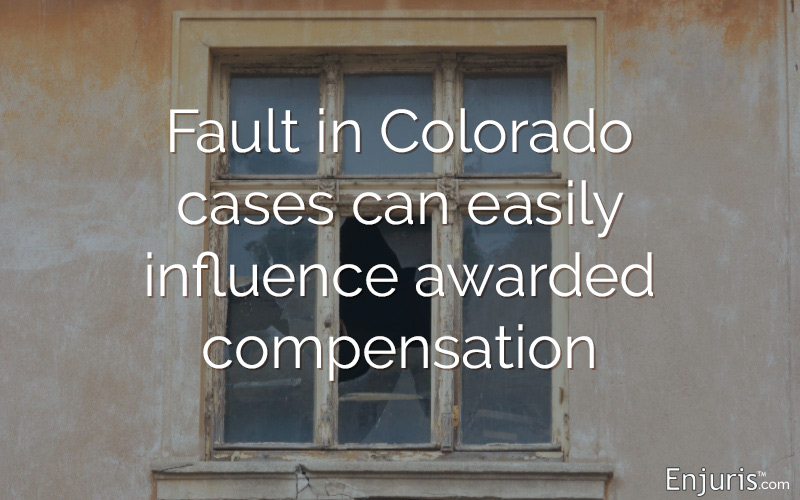Determining fault, insurance requirements, and how to settle a claim
The factor that is most determinative in predicting whether a personal injury victim will be able to recover is whether fault can be shown.
Colorado law allows personal injury victims the right to pursue compensation for the losses that they sustain when someone else is legally responsible for them.
Fault in automotive accidents
Every state handles automotive accidents differently. Most states use a fault-based system in which the driver who is not at fault pursues compensation through the other driver's insurance policy. The at-fault driver can also seek compensation through his or her own insurance company provided that he or she has an insurance policy to this effect.
In some states, lawmakers have tried to cut down on the number of lawsuits by instituting a no-fault insurance regime. In these states, each driver would pursue compensation for medical expenses and lost wages under his or her own insurance policy regardless of which driver was at fault. The rationale behind this system was that there would be fewer lawsuits since there would not be a need to point blame on the other party at all.
Colorado had a no-fault system until 2003 when it adopted a fault system. Insured drivers have three basic options when they get in an accident:
1) File a claim with one's own car insurance policy.
2) File a claim with the at-fault driver's insurance company.
3) File a lawsuit against the other driver.
Minimum liability coverage
Under Colorado law, each driver must maintain a minimum amount of insurance coverage, including the following:
- $25,000 per person for bodily injuries
- $50,000 per accident for bodily injuries
- $15,000 per accident for property damage to the injured party
Drivers may purchase additional insurance to cover their own needs such as paying for their own medical bills or those of their passengers. Colorado mandates auto insurance companies to offer $5,000 in med pay to cover their own medical bills, but drivers can opt out if they choose.
Uninsured motorist coverage
It is not required for drivers to purchase uninsured or underinsured motorist coverage; however, this coverage provides for a person's own expenses in the event that the at-fault driver has no insurance or has inadequate coverage. Colorado drivers can choose to purchase this insurance if they wish.
Damages
The amount of compensation that a person receives for a personal injury is based on the amount of damages that he or she alleges and can prove with evidence. Damages include all economic and non-economic losses suffered by the victim, including the following:
- Medical expenses incurred
- Anticipated medical expenses
- Lost income
- Lost earning capacity
- Physical disfigurement or disability
- Pain and suffering
Comparative negligence
In many cases, the person who is believed to be at fault turns around and tries to blame the other person for the accident. Even if he or she accepts some responsibility, he or she may claim that the other party's actions helped lead to the accident.
Colorado uses a comparative negligence model when the injured driver's own negligence contributed to the accident. Colorado law allows a victim to recover some of the damages that he or she sustained even if he or she was partially at fault.
Tweet this
The previous rule was that if the victim contributed to any degree to the injuries that he or she sustained, there would be a total bar from recovery. This was known as pure comparative fault. However, Colorado has since rejected this harsh rule in favor a modified comparative fault system.
According to this new model, a victim is able to recover for some of the damage that he or she sustained as long as he or she is not at least equally responsible for the accident. For example, if the victim is hurt in an automotive accident with $500,000 of damages and he or she is found to be ten percent at fault, he or she can still recover compensation. However, the amount of damages would be reduced by the plaintiff's apportioned amount of fault, in this case ten percent. Therefore, the plaintiff could still recover $450,000.
If the victim was found to be 50 percent responsible, he or she cannot recover because the victim is equally at fault. The victim cannot recover $250,000 even though the other party was at fault for this amount.
This concept affects how a judge or jury apportions damages. After deciding the amount of damages sustained, the judge or jury determines the amount of fault to attribute to each party and reduces the victim's award by the amount that he or she is responsible for. If the case does not go to trial, an insurance adjuster may try to reduce the amount of a settlement offer by the degree of fault that it alleges the victim was responsible for.

“When an accident occurs, drivers often start pointing fingers. Deciding who is to blame in many situations, however, can be a difficult task. This is where comparative fault (or comparative negligence) comes into play.”
Mack Babcock
Enjuris Partner Attorney
Proving fault
There are a number of ways that a personal injury victim may be able to establish the defendant's fault in the accident. Fault is not usually based on the other driver's intent to cause harm. Instead, it may be based on careless behavior on the part of the other driver, such as speeding, texting while driving, violating a traffic rule, or otherwise not acting with the ordinary care another person would have exhibited.
Settlement offers
The vast majority of lawsuits do not end in a trial. Instead, they are settled outside of court.
A personal injury victim may retain the services of a personal injury lawyer to represent his or her interests. The lawyer handles communications between the insurance adjuster and the other lawyer, if applicable. These parties negotiate a settlement, and the victim's lawyer informs the victim of the negotiated settlement amount. The victim can decide whether to take this settlement or whether to proceed with a personal injury lawsuit against the party responsible for the accident.
If the victim decides to proceed with trial, he or she bears the burden of proving that the other driver was at fault for the accident and that his or her own fault did not equal 50 percent or more of the liability assigned to the accident.
See our guide Choosing a personal injury attorney.


